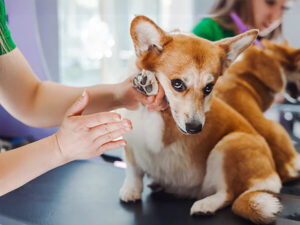Winter is a time when most people enjoy the various religious and secular holidays, spend lots of time indoors as the cold weather hits, and may even endure a few snow or ice storms. Naturally, this means your pet pooch is spending more time indoors as well. So, does this mean they won’t get dirty, develop matted hair, or need as much grooming during winter as in warmer months? Should you ensure your dog’s coat remains as long as possible so that they aren’t cold during the winter? The answer to both of these questions is no!
Dog grooming during winter remains as important as any other time of year. The combination of less outdoor activity, colder temperatures, and moisture from snow or ice can all mean that hair becomes more matted or tangled than ever, especially if you relax your grooming routine. It’s a vicious cycle, with matted and tangled hair retaining more moisture, becoming more matted or tangled, and so on. This can ultimately lead to skin irritation or other skin conditions, and even the need for stripping (short shaving) the matted hair. Likewise, keeping hair extra long to make winter more comfortable for your pet can do more harm than good. In fact, they would be better served with some protective dog clothing if you are concerned about their temperature and cold exposure when outdoors on walks.
As ever, let’s address some of the core areas of dog grooming, and what you should do to take care of your dog’s needs when grooming during winter months.
Bathing
Unlike some animals, dogs are perfectly well-suited to tolerating baths all year round, including during colder winter months. Proper bathing, cleaning, and conditioning of your pet’s coat will help reduce matting or tangling, which typically increases and is more likely when their coat is dirty or has been a long time between baths.
Of course, that doesn’t mean you shouldn’t take some steps to ensure your dog’s warmth and comfort during and after their bath during the winter. Rather than room temperature water, you may want to use slightly warmer water than you would at other times of the year (though not hot). Use a mild shampoo, and ensure you work it all the way to the base of their coat. After rinsing, you may wish to wash them again, especially if they have a thick or particularly dirty coat. Then, after a final rinse, apply conditioner. This step is critical, as it helps to restore the oils that are removed by washing, will make brushing and combing easier, and helps your dog to maintain proper coat health during the colder and dryer winter months, which can otherwise dry out their coat. It will also help cut down on unwanted static shocks, which can be quite a…well, shock…for you and your pet.
Lastly, dry your pet as per normal. Most experts recommend patting and squeezing with a towel, or using a hair dryer (on the cool or room temperature air setting, or, at most, the warm setting, never hot). Dog dryers are also suitable. Be sure to dry your dog thoroughly, and keep them indoors for a few hours afterwards to ensure that they are fully dry before exposing them to cold outside air. You can also bundle them up in a blanket or dry towel for a short time after drying to help keep them warm, if necessary or desired.
Ears
As most pet owners know, one main principle of the bathing process is to avoid getting water or soap into your dog’s ears. They still occasionally will need to be cleaned, however. To do this, shortly after the bath, it’s best to use a dog ear cleaning solution, and apply it into their ears per the instructions. These solutions are made specifically to be safe for dogs, and to help remove wax and any debris, soap, or water that got into the ears during bathing. Removing moisture from their ears is critical, as it otherwise can lead to infections, just as in humans.
Coat Brushing and Combing
The vast majority of pet owners find it easiest to comb or brush their dog’s coat after they have been bathed and dried off. After all, it’s cleanest and should be the easiest to work with at this point. Brush or comb as per normal, working from their skin outwards to the tips of their coat, removing any tangles or mats as you go. If you need a moisturizer or grooming aid, coat spray may be useful – you can find them at pet supply stores and online, containing a variety of additions, such as deodorant, probiotics, and more.
Typically, most professional dog groomers prefer a high-quality slicker brush for grooming, with a second pass using a metal/steel comb. Most dogs need grooming at least twice a week, or more frequently, to avoid matting and tangles in their hair. Cutting back on combing and brushing can lead to an increase in shedding during the winter months, and maintaining a consistent and regular grooming routine can help to combat this.
ALSO READ – Everything You Need to Know About Dog Shaving
Spot Cleaning or Freshening Up
You don’t want to over-bathe your pet, either. As we’ve highlighted in other articles, it’s best to only bathe your dog once every other month or so, but definitely no more frequently than once per week for a regular cleaning. That interval should be longer if your dog is prone to irritated skin following bathing. In between times, some spot cleaning or freshening up may be required, and this is true in winter as much as it is the rest of the year. Pet wipes are good for spot cleaning, and especially useful for paws, long hair, or their behinds. Some also contain moisturizer and/or scents to keep your dog smelling fresh, too.
Paws, Pads, and Nails
One area that needs special attention on your pet during the winter is their paws, paw pads, and nails. Often, many areas around the country and world use salt or other de-icing agents on sidewalks and roads during the winter time, especially if snow or ice is in the forecast or has recently fell. These can irritate your dog’s paws and pads, as well as the skin on their legs. Depending on the de-icer used, it can also work its way in between paw pads and become a constant source of irritation, even resulting in limping or walking issues until they are removed and cleaned.
One of the easiest ways to deal with this is to ensure you wash your dog’s paws with warm water after any walk on surfaces with de-icing products. Many people prefer to skip this step, and protect their dog’s paws and pads from exposure in the first place, by applying dog booties. This also serves the additional purpose of helping to keep their paws and paw pads warm, which is important because extremely cold concrete or asphalt – even without de-icing solutions – can still irritate their paws and cause discomfort.
Lastly, you want to ensure you check your dog’s nails often. Because pets are typically less active during the winter months, their nails or claws can actually seem to grow faster, and require more frequent trimming. As with the rest of the year, proper trimming tools and supplies are recommended if you trim your own dog’s nails. Others prefer to leave that up to vets or professional groomers, in which case you may need to increase the frequency of appointments during the winter.
Concluding Thoughts on Grooming During Winter Months
The cold winter months, with much more time spent indoors, may seem like a time to get a bit lax with your dog grooming, but really, the opposite is the best approach. Regular grooming, or even slightly more frequent grooming in some areas, is the best way to keep your pet happy, healthy, and feeling great. Regular bathing, combing or brushing, trimming of nails, and ear care is required, just like any other time of year. Additional protection for sensitive paws and paw pads during cold, or when de-icing products may be present on outdoor surfaces, is also important. Ensuring your pet is properly groomed and cared for will give them the best quality of life, and help ensure they stay looking and smelling great while cooped up inside, too!
ALSO READ – The Top 5 Grooming Mistakes You Should Avoid





